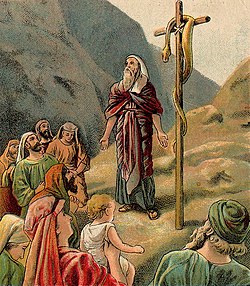Ophites
The Ophites, also called Ophians (Greek Ὀφιανοί Ophianoi, from ὄφις ophis "snake"), were a Christian Gnostic sect depicted by Hippolytus of Rome (170–235) in a lost work, the Syntagma ("arrangement").
It is possible that, rather than an actual sectarian name, Hippolytus may have invented "Ophite" as a generic term for what he considered heretical speculations concerning the serpent of Genesis or Moses.
In addition, Eve is said to have believed the serpent, as if it had been God the Son (Eua quasi filio deo crediredat; 2.4).The name "Jesus" is not mentioned in the account.
In this book he makes a contemptuous mention of the Ophites in company with the Cainites and Nochaitae (8:20) as heretics whose doctrines did not deserve the compliment of serious exposition or refutation.
But it came to pass that these sons strove for mastery with their father Ialdabaoth, whereat he suffered great affliction, and casting his despairing gaze on the dregs of matter below, he, through them, consolidated his longing and obtained a son Ophiomorphus, the serpent-formed Nous, whence come the spirit and soul, and all things of this lower world; but whence came also oblivion, wickedness, jealousy, envy, and death.
Thereupon Ialdabaoth cast Adam and Eve out of Paradise; but the mother had secretly emptied them of the Light-fluid in order that it might not share the curse or reproach.
The above is clearly a variant of the account of the Creation given in chapter 1 of The Book of Genesis – but with the major difference that the single, omnipotent God of the original Biblical story is here depicted as Ialdabaoth – one of many Divine beings, and not the most important of them, with his claim to exclusive Godhood described as an arrogant and false usurpation.
In particular the prophets who were each the organ of one of the Hebdomad, the glorification of whom was their main theme, were nevertheless inspired by Sophia to make fragmentary revelations about the First Man and about Christ above, whose descent also she caused to be predicted.
Sophia, apprized of the coming help, announced his advent by John, prepared the baptism of repentance, and by means of her son, Ialdabaoth, got ready a woman to receive the annunciation from Christ, in order that when he came there might be a pure and clean vessel to receive him, namely Jesus, who, being born of a virgin by divine power, was wiser, purer, and more righteous than any other man.
Then Ialdabaoth and the other princes of the Hebdomad, being angry, sought to have Jesus crucified, but Christ and Sophia did not share his passion, having withdrawn themselves into the incorruptible Aeon.
Jesus then remained on earth after his resurrection eighteen months, at first himself not understanding the whole truth, but enlightened by a revelation subsequently made him, which he taught to a chosen few of his disciples, and then was taken up to heaven.
The consummation of all things will take place when, by successive union of righteous souls with Christ, the last drop of the Light-fluid shall be recovered from this lower world.
It begins with "the spirit of God moving on the face of the waters," and it summarises the subsequent history, even mentioning the sacred writers by name.
Yet that it is not the work of those amicable to Judaism is evident from the hostility shown to the God of the Jews, who is represented as a mixture of arrogance and ignorance, waging war against idolatry from mere love of self-exaltation, yet constantly thwarted and overcome by the skill of superior knowledge.
In the passage immediately following the chapter we have analysed, Irenaeus shows acquaintance with a section of the school who may be called Ophite in the proper sense of the word, some teaching that Sophia herself was the serpent, some glorifying Cain and other enemies of the God of the Old Testament.
In the section of Irenaeus immediately preceding that of which we have just given an account, there is a summary of a system which has been called Barbeliot, from its use of the name Barbelo to denote the supreme female principle.
It contains some of the essential features of the scheme just described, of which it seems to have been a development, principally characterized by a great wealth of nomenclature, and, with the exception of the name which has given a title to the system, all derived from the Greek language.
Origen (c. 185–254) is led to speak of the Ophites (Contra Celsum 6:28) by an accusation of Celsus that the Christians counted seven heavens, and spoke of the Creator as an accursed divinity, inasmuch as he was worthy of execration for cursing the serpent who introduced the first human beings to the knowledge of good and evil.
Elsewhere Origen classes the Ophites as heretics of the graver sort with the followers of Marcion, Valentinus, Basilides, and Apelles (Commentary on Matthew 3:852).
And through it, as they say, they send forth a hymn to the Father on high, thus concluding their mysteries.Ophite teaching was, most likely, dying out in the days of Hippolytus; in the time of Epiphanius it was not absolutely extinct, but the notices in his work would lead us to think of it as but the eccentric doctrine of some stray heretic here and there, and not to have counted many adherents.
In the 5th century Theodoret tells (Heresies 1:24) of having found serpent worship practised in his diocese by people whom he calls Marcionites, but whom we may believe to have been really Ophites.



